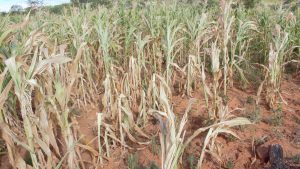

AS the effects of the El Niño-induced drought start to bite in Zimbabwe, calls are intensifying for urgent climate adaptation measures.
The southern African nation, currently grappling with the effects of the El Niño-induced dry spell, has seen recurring climate change-induced natural disasters and unpredictable weather patterns.
The country recorded the lowest harvest since the 2015/16 production season, another drought year, indicating a significant shortfall in the country’s food supply.

The area of maize written-off was 908 004 hectares out of 1,777,540 hectares due to El Niño-induced drought
The drought – the worst in 40 years – resulted in a 72 percent decline in staple maize production for the 2023/24 season according to the Ministry of Agriculture.
“All our crops failed and we did not harvest anything. We appeal to the government to issue out effective early warning systems so that we can take proactive measures in the future,” Pritchard Ncube from Chidobe Village in Matabeleland North said.
For Musawenkosi Dube and her children, the hardship has been so extreme that she has to travel long distances to get water.
“We are not only short of food but our water source has dried out and we have to walk long distances to find water. If only the government can assist in the construction of rainwater harvesting structures like reservoirs to capture and store rainwater for use during dry periods,” the mother of two said.
Another villager, Davison Mabhena, said he had lost his livestock due to the drought.
“I can’t afford to buy stock feed. We can’t even sell our livestock because the cattle are currently malnourished. I heard the government will be supplementing livestock feed in some villages. Our appeal is that they also cover our village,” he said.
With extreme weather events becoming increasingly frequent and severe, experts have called on authorities to implement strategies for climate-proofing agriculture and ensuring sustainable water management.
Climate risk management expert Elisha Moyo said the frequency and intensity of droughts in the southern African nation are expected to increase significantly in the future.
He highlighted that communities can adapt to drought conditions by cultivating drought-tolerant crops and livestock, such as small grains and goats.
“The major adaptation strategies for Zimbabwe include decoupling crop production from rainfall by adopting a wide range of climate risk management practices at national, district and community/household levels such as establishing irrigation systems and other water-conservation assets such as dams, weirs, in-field structures such as infiltration pits,” Moyo said.
 To mitigate financial losses, he said individuals and communities can explore options like micro-insurance or weather index insurance.
To mitigate financial losses, he said individuals and communities can explore options like micro-insurance or weather index insurance.
He implored authorities to also implement sovereign or macro insurance programs to protect vulnerable populations during droughts.
Moyo said the current drought is one of the worst in several decades and a classic example of the season shortening expected in the future following the abrupt end of rainfall season by mid-February.
He highlighted a worrisome trend in the intra-seasonal shift towards extreme weather patterns where the number of rain days will be reduced and the rainfall season is characterised by few very heavy rain days.
“This affects water security as there isn’t enough time for the water to infiltrate, affecting millions of rural populations watered from groundwater,” Moyo said.
On his part, Daniel Sithole a climate change expert and director of Green Shango Environmental Trust said the effects of climate change on Zimbabwe’s agriculture emphasise the urgent need for improved irrigation development and sustainable water management techniques.
“Given that agriculture accounts for a large portion of Zimbabwe’s economy, the economic impact is substantial. It is critical to implement strategies for climate-proofing and sustainable water management practices,” Sithole said.
He highlighted that Zimbabwe can significantly contribute to global climate change mitigation by encouraging conservation agriculture to improve soil health and sequester carbon.
He also noted that lowering deforestation through the use of sustainable forestry techniques and increasing the use of renewable energy sources can go a long way in climate mitigation.
On his part, climate expert Christopher Mabeza highlighted that extreme weather events have become more frequent and more intense.
“Climate change adversely affects people’s livelihoods. Given that rural populations mostly engage in rain-fed agriculture, they have nothing to fall back on when drought occurs,” he said.
President Emmerson Mnangagwa recently called for urgent innovative solutions to mitigate the effects of climate change, which is projected to make the region more drought-prone in the coming decades.
“It is now urgent and imperative that we think outside the box to de-risk our nation from the vagaries of climate change. Similarly, stakeholders and communities alike should accelerate the implementation and adoption of mechanisms to climate-proof our agriculture sector, beginning at the household level,” Mnangagwa said recently.
The government has issued a dire warning on the devastating impact of the drought, stating that an estimated 7,7 million people are facing food insecurity in Zimbabwe.
Of these, six million reside in rural areas, while 1,7 million are located in urban centers. As a result, the government has announced that urgent food assistance will be necessary to prevent widespread hunger and suffering.
Zimbabwe is highly vulnerable to climate variability and change, with the southern African nation ranking among the top three countries in the world most affected by climate change according to the 2021 Global Climate Risk Index.